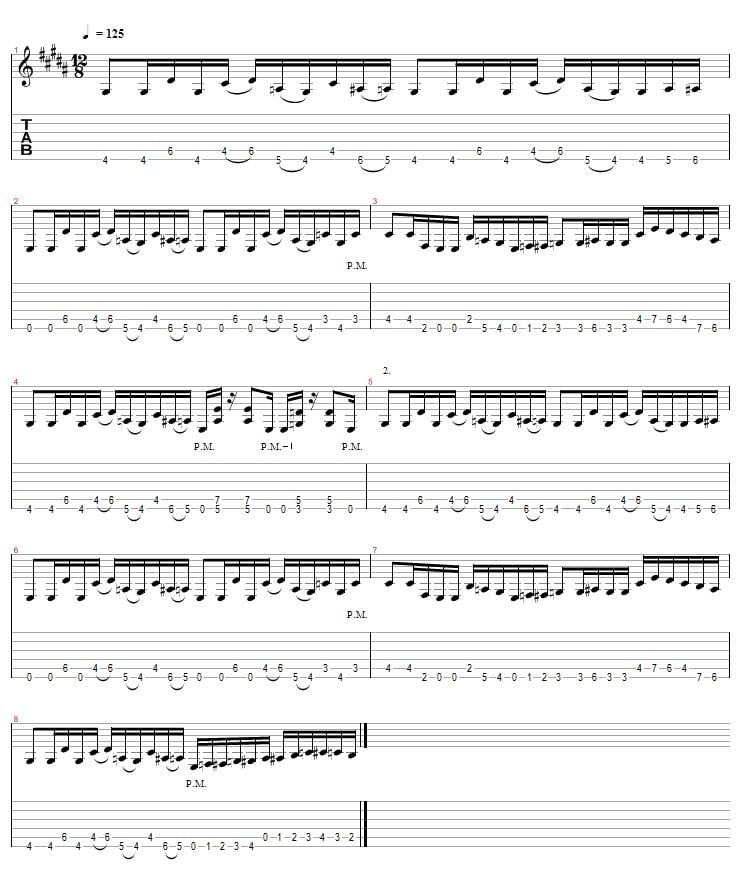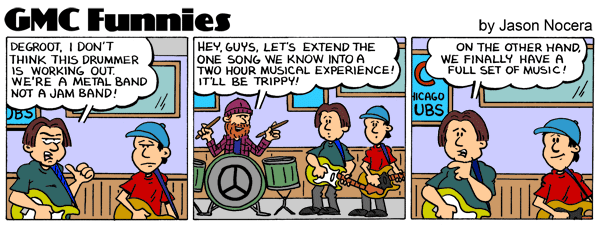Cracking The Code Of Clever & Catchy Chromatic Chops 01, Some of my ideas about creating interesting riffs |
|
|
|
|
|
| Feb 4 2013, 07:09 PM |
|
There are a lot of ways to create interesting melodies and riffs, and one of them is the way of Creating Clever & Catchy Chromatic Chops. (And despite of the lot of C-s in the title of my lesson, this can be used in any key!)
So, what comes into your mind when you hear the term ‘chromatic notes’? Many players, especially in the beginner and intermediate phase, tend to shy away from the conscious use of chromatic notes. If you are a rock/metal guitarist, then you may have chosen not to use chromatic notes because you associate it with jazz music and you don’t want to sound like Chick Corea on a rainy Monday morning. Or you may have met with lots of chromatic picking exercises as a beginner, and you are fed up with them because they sound vague and unmusical, and they even pop up in your worst nightmares along with Freddie Krueger knocking on your front door. If you see yourself belonging to either of the above group of players, then I can assure you: chromatic notes can be really cool, trendy and metal! Chromatic notes can be your friend. Chromatic notes can do everything for you except opening a can of beer. (But maybe they can do even that, just be sure to place your amp REALLY close to the can!) Let’s start our journey to Chromatic City, which is located closer to Metalville than you have ever thought. I show you the main chromatic riff as well as the main theme of my song Golden Sun, from my 2009 debut instrumental guitar album „Sharp Guitars From a Flat Planet”. This song is a neoclassical piece. Although I don’t often write neoclassical music (because I’m dwelling rather in the genres of metal, modern rock and progressive metal), this song has been my way of paying tribute to some of my inspirations like Yngwie Malmsteen, Vinnie Moore and Tony MacAlpine. This song has been also featured in the new shred talents compilation CD “Shredding Across The World Vol.3” released by Shredguy Records, you can listen to the clips on Amazon, iTunes, and Guitar9.com. As you can see in the tablature, the main riff of the song is in the key of G# minor. This key contains the notes G# A# B C# D# E and F#. The riff starts with the root note, then jumps up to the fifth, back to the root, then up to the fourth - so it seems to be a rather straightforward tune so far. And this conventional start is really useful - that way you can lay down the foundations of the song and invite the listener to come a bit more inside - “Relax mate, it is just a cool riff with fifths, no need to worry!" The listener breaks into a huge grin and walks inside - and then, the saber-toothed tiger jumps on him! Of course, it doesn’t have to be a real saber-toothed tiger, but after a conventional start, you can sweep the listener off his feet with a dose of chromatic passing tones. So it is wise to begin your tunes with some important notes of the key. The first chromatic note (i.e. a note which is not contained by the key of G# minor) is the note A on the 5th fret of the low E string. In the accompanying mp3 you will hear how well this short chromatic note leads downwards to the root (4th fret). Note also, that this chromatic moment occurred on an unaccented beat. Right before “half-time” of the first bar, a similar chromatic idea appears, but this time it is a longer descending line, containing the notes A#-A-G#, and again, the line is leading to the root note (frets 6-5-4). In the second half of the first bar, I have played a similar pattern, with a little twist at the end of the bar (the chromatic line is now ascending here). In the second bar, the harmony changes to an Emaj7 chord, and therefore I'm playing E notes (open low E string) instead of the G# notes. It is worth noting, how the rhythmic structure and all the other notes have remained the same here, ensuring the continuity of the riff. However, these notes are representing a different degree of the chord now. For example, the D# note (fret 6 on the A string, third note of bar 2), which had been the fifth of the G# minor chord in the first bar, is now the major seventh of the Emaj7 chord. At the end of the 2nd bar, there is a tricky ending, using the notes C, G# and C. Here, the note C (which is in fact a B# here when applying the rules of music theory strictly) is a chromatic passing tone as well, leading perfectly to the C# in the 3rd bar. Bar 3 starts with an accompanying C# minor chord (that’s why the chromatic line C-C# has been a good choice here), changing to a G diminished seventh chord in the second half of the bar. To emphasize the harmony change, a whole series of chromatic notes are played (0-1-2-3) in the middle of the bar, leading to the root of the G diminished seventh chord. Bar 4 has another surprise for you. It begins with the same pattern as in the opening bar, but it breaks the pattern around half-time with two power chords (both played on the upbeat). The power chords are an A5 and a G5 (neither of A and G are present in our key of G# minor), and they are representing the end of the whole 4-bar figure. So here, I have created a “sandwich” of notes, with the A5 and G5 being the bread and the G# note (which will come right next as the 4-bar figure keeps repeating) being the meat. It is really simple: if you know your important note (in our case the G#) then first play the both the notes below and above a half step of the important note, and then play the important note itself. This is a really cool way to use chromatic notes - your riff will sound more unpredictable and at the same time this trick clears the ground for the important note, using the tension-resolution principle. In the bars 5-8 I have repeated the above four-bar figure, with one significant difference. If you look at the second half of bar 8, you’ll find tons of chromatic notes (0-1-2-3-4 on both low strings). After the more subtle usage of chromatic notes in the main riff, this kind of “in-your-face” chromaticism creates a great contrast, and it is perfect for closing the repeated riff, preparing a new riff or even a key change. I uploaded the riff on Soundcloud, and you can listen to it by clicking here: http://soundcloud.com/jonas-tamas/golden-sun-chromatic-riff-1 This is the TAB of the chromatic riff: 
|
|
|
||
1 User(s) are reading this topic (1 Guests and 0 Anonymous Users)
0 Members:






















